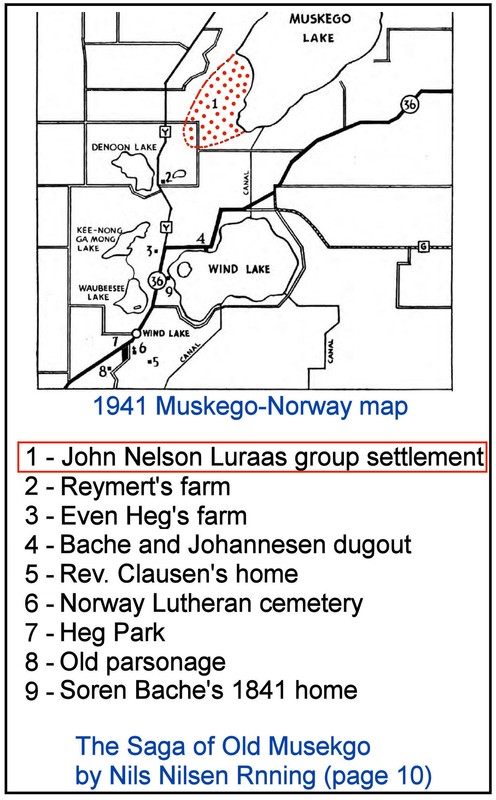Muskego Dam Road
Introduction
Text-to-speech Audio
When John Nelson Luraas and his fellow immigrants arrived in Milwaukee, residents recommended that they head southwest twenty-five miles to unclaimed land. The dried-out August marshlands looked like fertile fields, with grasses so tall that a man could get lost in them. They looked like the rich farmland at home along the craggy Norwegian coast.
They mistakenly built their cabins on swamplands. In the spring, their cabins were water-logged; by summer, malaria-carrying mosquitos rendered the colonists weak and unable to work. Crossing the bridge over the outflow of Big Muskego Lake near where Luraas settled, even today it is evident that hard work doesn’t always guarantee dry and tillable soil, no matter how much tiling and draining is done.
After four years at Muskego, Luraas and his suffering family had had enough. They loaded their ox cart and moved to Koshkonong. They prospered as the first settlers of the Town of Dunkirk in Dane County.
Images
Luraas settlement site off of current Muskego Dam Road.

Backstory and Context
Text-to-speech Audio
Stories told by Ansten Natesta during his visit back to Norway in 1840 excited many in south-central Norway. A group of forty excited and hopeful people from Tinn and Hjetdal in upper Telemarken wanted to emigrate with Natesta when he returned to America. But because there wasn’t room aboard the ship, they had to travel to Skien to board another schooner. Half of that group were members of John Nelson Luraas’ extended family.
Luraas explained why he came to America:
I was my father’s oldest son, and consequently heir to the Luraas farm. It was one of the best in that neighborhood, but there was a (large) mortgage on it. I had no opportunity of getting money. It was plain to me that I would have a hard time of it, if I should take the farm with the debt . . . pay a reasonable amount to my brothers and sisters and assume the care of my aged father. I saw to my horror how one farm after the other fell into the hands of the lendsmand and other money lenders.[1]
There were almost always unplanned delays and extra expenses on the emigrant journey. When Luraas’ group reached Buffalo, New York, they made a risky choice. To save money, they contracted with a schooner captain to transport them at a cut-rate price to Milwaukee. They booked passage on a barely seaworthy sailing ship loaded with explosives. Twice their ship almost sank. In a tempestuous storm, one woman was washed overboard, never to be seen again.
At Milwaukee, the ship had to anchor offshore because the not-yet-dredged Milwaukee harbor wasn’t yet deep enough for ships to safely enter the river and dock. Passengers and luggage had to be unloaded into rowboats and rowed to shore. Once safely on land in Milwaukee, the local residents gave them a skit to convince the newcomers to settle in the area. Luraas recalled this greeting:
The day after we arrived, some Milwaukee people came on board the vessel. They asked what we intended to do in America. We told them we were farmers and desired to buy land and were thinking of going to Illinois.
We were told, ‘go where you like, this is a free country. But if you want to do what is best for yourselves, then take my advice.’ He then presented two persons, one who was a large fat man, the picture of health, while the other was a mere skeleton, all emaciated from disease. He said ‘this fat man is from Wisconsin, where there is a healthy climate and an abundance of food; this invalid is from Illinois where people are burnt up by a scorching heat and where they die from malarial fever. Now choose as you think best’
It was a hot August day. (We) were perspiring in (our) thick woolen clothes (and) thought with dread of the heat in Illinois, where we would soon be changed into skeletons. We went ashore in Milwaukee, a city which was then in its infancy . . . The fat man exhibited to us was the well-known (George H.) Walker after whom the present south side of the city was called Walker’s Point.[2]
Luraas’ group made the “Beaver Creek mistake” of settling on wetlands. The summer drought changed the marshes of springtime into seemingly verdant grasslands. In the spring, the group’s log cabins were underwater. Almost two centuries later, some of those lands first bought by the Norwegians still have not been drained or coaxed into farmland. Some of those who claimed land on higher ground stayed; most left. Failing farmers eventually migrated to a new edge of the frontier. John Nelson Luraas and other initial Muskego settlers abandoned their poor farmland and tried their luck in the more bountiful Koshkonong settlement. Luraas was the first Norwegian settler in Dunkirk Township, of which is home to the very Norwegian American village of Stoughton.
Sources
[1] Nilsson, Svein. A Chronicler of Immigrant Life, page 11
[2] ibid, page 14
Anderson, Rasmus. The First Chapter of Norwegian Immigration (1831-1840) its Causes and Results (Madison WI, 1895)
Hanson, Karen. In Jesus' name shall all our work be done : commemorating the 150th anniversary of Norway Evangelical Lutheran Church, Wind Lake, Wisconsin, 1843-1993. (Wind Lake WI,1992)
